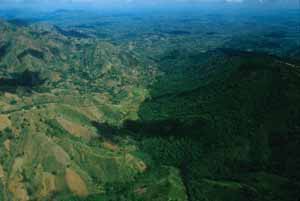


|
|
National Geographic Image Collection/James P. Blair.
|
|
1987 photo starkly shows deforestation in Haiti, left, contrasted with green forests on Dominican side of border. Because of imperialist distortion of Haiti’s economy, working people in rural areas lack access to electricity or modern fuels, forcing them to rely on charcoal made from wood. Deforestation has turned heavy rains into devastating floods.
|
Aid workers in some cases have been reduced to loading up mules to deliver supplies of food, clothing, and other necessities to thousands of flood victims in the hardest-hit areas.
The consequences of this capitalist-bred catastrophe are being felt most deeply in Haiti, where three-quarters of the deaths have occurred.
Deforestation in Haiti—the result of decades of imperialist domination—is a major reason for the magnitude of the disaster for those living in the area, especially in the Haitian towns of Mapou and Fond Verrettes and the nearby village of Jimaní in the Dominican Republic.
Only 1 percent of Haiti’s land has tree cover. In the neighboring Dominican Republic it is only 15 percent. With no tree roots to hold soil to the mountains, the rains that began in mid-May by May 24 rapidly became flood waters and brought with them waves of silt, gravel, and boulders that slammed into villages.
The disappearance of the woodland is the product of the lack of most forms of modern fuel in rural areas, which forces working people to cut wood for their own use or to sell it for charcoal—the only means of survival for many. This situation is compounded by the lack of electricity and inadequate roads, housing, and communications, as well as the virtual absence of medical facilities. The U.S. capitalists, who for decades have viewed Haiti as a source of cheap labor and natural resources, and the wealthy Haitian families who rule that country, have never considered such facilities to be priorities.
The arrival of the wet season in June brings the potential for worsening the disaster for working people. Where the May rains did not devastate towns, they created dams above them from debris that can break open with a new burst of rainfall. The Haitian villages of Bawa, St. Michel, Nan Galette, and Naroche are all in immediate danger.
“Our biggest concern right now is that these four villages are at risk of landslides, mudslides, and rockslides,” Bernard Barrat of the Red Cross told the BBC. As an indication of the minimal assistance Haitian workers and peasants are receiving in the face of this imminent threat, he said, “We’ve distributed plastic sheeting for people to make temporary shelters in hilly areas.”
Among the first on the scene to aid the victims of this social catastrophe have been Cuban volunteer doctors. More than 500 Cuban medical volunteers are providing vital health-care services in Haiti, including in remote areas of the countryside where Haitian or U.S. doctors would refuse to work. Two Cuban doctors are staffing a clinic set up in Mapou, where the “lake” around the town still contains many bodies and dead animals. The Caribbean Disaster Emergency Response Agency reported that a Haitian relief engineer “and four Cuban doctors managed to arrive to Fond Verrettes by land though the last five kilometers had to be on the dry river bed.”
In contrast to the response to the calamity by the Cuban medical personnel, on May 31 Washington ordered a halt to the use of its military helicopters for delivery of emergency supplies to areas cut off by the flooding. A U.S.-led force of 3,600 troops from the United States, France, and Canada, has been in Haiti to “restore order” for the government of Haitian prime minister Gérard Latortue.
Latortue was put in power as a result of a rightist rebellion in February. The elected president of Haiti, Jean-Bertrand Aristide, was shanghaied by U.S. troops and taken by plane to Africa. After spending several weeks in Jamaica, he is now living in South Africa.
On June 1 the first of a projected 8,000-strong United Nations military and police force formally took over control of the occupation from U.S. forces. It is likely that Washington will keep some kind of military force in Haiti in the future.
Like the departing U.S. forces, the UN troops and cops, headed by a Brazilian general, have put flood relief on the back burner.
“The UN peacekeeping mission doesn’t have helicopters right now, and it will take weeks for them to deploy some,” a representative of the UN food relief agency told the New York Times by way of explanation. The agency’s director in Haiti said, “We deeply deplore that the multinational force has other priorities.”
The Times reported June 1 that “the aid workers are talking about using mules to ferry aid to thousands of victims. Given the state of Haiti’s interim government, the agencies say they may have to rent bulldozers and rebuild ruined roads themselves.”
Front page (for this issue) |
Home |
Text-version home